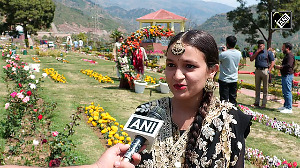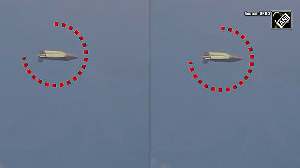
For almost a decade now, the softspoken Dr K Kasturirangan has led the Indian space programme as its chairman.
During his tenure, India began marketing her space services in the global marketplace. It also entered an exciting new phase of space programme with repeated launches of the GSLV, the launch vehicle that can place satellites weighing two tonnes and above into geo-stationery orbit.
Dr Rangan has now embarked on a new phase in his career. His nomination to the Rajya Sabha has just been approved by his former colleague at the Indian Space Research Organisation, President A P J Abdul Kalam.
Just before he handed over charge to his successor G Madhavan Nair, who is yet to be officially anointed, Dr Rangan gave Special Contributing Correspondent M D Riti exclusive insights into the status of key ISRO projects like the moon mission, cryogenic engine research, India's take on the Chinese space programme and the selling of space services.
What spacecrafts, satellites and launchers will you use for India's moon mission, Chandrayaan?
The scientific community decided we should explore the possibility of going to the moon. Then, the whole ISRO initiative in this direction was based on our capabilities, in two areas: launch vehicles and satellites.
Today we have both the PSLV with nearly 1.3 tonnes into a sun synchronous orbit and nearly a tonne into a geo synchronous transfer orbit.
The GSLV can put two tones into a geo synchronous transfer orbit. This is a capability for launch.
On the satellite side, we have developed a variety of satellites: satellites for remote sensing -- the IRS series -- very sophisticated satellites with advanced camera systems. Then we have the multipurpose communication satellites of the INSAT series. More recently, we have developed lightweight systems up to a tonne, the first of which was the meteorological satellite, the Kalpana.
We decided these capabilities could suitably be tailored for a lunar mission. Technically, we came to the conclusion that we can use the GSLV in a geo synchronous transfer orbit for mission. Then can we use a bus similar to what we used for the Kalpana. Then we can put a spacecraft with adequate instrumentation to look at the moon, and that has to be developed of course.
That would essentially enable us to put a one tonne satellite into geo synchronous transfer orbit, using the propellants and so on, by the time it reaches the moon, it would be more like just under 500 kilograms. It could then be put into lunar orbit and we could make measurements over the lunar surface by orbiting it about 100 kilometres over the surface of the moon.
This is the premise: the technological capability of the launch vehicle, or a lightweight satellite like the Kalpana, and our confidence in our ability to build the right instrumentation, because some of it is much like what we have already developed for remote sensing, like the terrain mapper, spectroscopy for gamma rays, X rays and so on. We have already done all this either for science or for space applications.
Lastly, we have a strong group that can work on celestial mechanics. The entire mission is quite involved when it comes to computation of the orbit, the way the trajectory has to be tailored and how to encounter with the moon, and finally, insert the satellite into the orbit of the moon.
This is a very involved exercise, but considering that we have worked out on several complex missions, we are confident that this part of it also may be developed as a part of the overall mission.
Will India collaborate with any other countries on its moon mission?
Yes, the moon mission provides a unique opportunity for international collaboration. We are collaborating with some other space agencies. We have some strong prospects of collaboration, with the European Space Agency and Canadian Space Agency, none of which has been finalised yet.
ISRO has been launching INSATs for over two decades now, but still does not figure either in the main list of top 20 satellite operators, or even in the supplementary list of five operators that are on threshold of commercial success, drawn up by the Washington-based international weekly Space News, on the basis of gross annual revenue earned by satellite operators around the world.
We are a government organisation, not a company. ISRO's space programmes are all geared to cater to the country's national needs. Commercialisation is not a priority at all. In fact, any commercial offering of INSAT transponders is done only after ensuring that the country's socio-economic development needs are fully met.
We may have been launching INSATs for many years, but we have started leasing out transponders only recently. Moreover, we use a majority of our transponders ourselves: we do not spare them for commercial sale. Naturally, we would not be within the world's top 25 space business agencies. You do not see NASA or ESA featuring on the Space News list either, do you?
China is busy planning manned missions. Why isn't ISRO? Do you think it's unnecessary?
Our priorities for space are set by our needs and the timeliness of certain types of capabilities and availabilities, and also where we should prioritise deploying our resources. And by resources, I do not mean money alone, but also manpower related to the infrastructure and so on.
We have a very focused programme which involves earth observation from satellites, communication, broadcasting, meteorology with satellites, launch vehicle development which will support these sort of satellites for remote sensing and communication, a space science programme that will cater primarily to the members of the scientific community who will work in high energy astronomy, environment and planetary exploration.
These are the broad directions we want to take in the coming years consistent with the type of investment that we need to make. We want to grow this activity.
If this overall scheme of things, a manned mission carried out entirely by India is by its very nature very intensive in terms of resource investments. If you really look at what it can yield, it is not consistent with the type of investment we would be making.
The crux of manned missions, as are being planned elsewhere, is that you get a gravity-free environment or micro gravity environment. You also get an opportunity to carry out experiments on material processing, physical growth, and pharmaceuticals.
But these can also be done by our using somebody else's manned capabilities, like the space station: have an arrangement with one of the partners of the space station to work together, and then carry out this micro gravity experiments.
We have the means to take that kind of approach that will still cater to a facility where we need to conduct experiment. If this calls for training an astronaut, that too we can do. But why should we go ourselves for a fully manned mission, designed, developed and operated by India?
Is India making any moves to be a part of the international space station being planned?
No, not at all. As and when its possible, we might make use of the opportunity for our scientific community to perform micro gravity experiments, that's all.
What is the latest on the sale of launch vehicle services?
We are giving opportunities for small satellites. We have one more booking from the Nan Young University of Singapore for a 100-kilogramme satellite to be launched on the PSLV. There are many enquiries from Europe and other places. We are trying to respond to them. But there are no concrete bookings on our PSLVs or GSLVs just now, apart from this.
When will the GSLV Mark 3 be ready for use?
It is past the design phase. We are now getting into the detailed reviews of the sub system design, like the propulsion, structure, control guidance navigation, and the aerodynamics, things of that kind.
Also we have now started building the facilities required for this launcher. You need a booster segment. Development is now in progress to cluster liquid engines to make an L110, which is a 110 thrust engine, as against a 37.5 tonne, which is the capability at present, a Viking type of engine, or a 40 tonne.
We need to go further on that. We also need to develop a cryogenic engine that is of a higher level of performance, which is a 20 tonne cryogenic for the upper stage.
The Mark 3 has a very different configuration. It really has just 1.5 stages, if you look at it. The configuration is very sleek. One has to still do a lot of aerodynamic wind tunnel simulation, and then put it through a lot of tests on structural components, a lot of tests on the boosters, evaluation of the upper stage.
A host of tests have to be done. We are just developing the hardware for the initial tests, which will lead to a final hardware for the flight version of the GSLV Mark 3.
The totality of the work involved in installing the necessary facilities, then completing the initial qualification of individual elements and simulation of them including aerodynamic tests in the wind tunnel and then going for final fabrication of the first test flight vehicle and then the test flight itself.
This should totally involve at least another 4 years. I would imagine this to be more in the time frame of 2008.
Will the Mark 3 be the next major step in commercialising Indian space services?
All capabilities have their commercial potential. The question is whether we can find the right customers who would be interested in this area, and we are pursuing this, whether it is in the remote sensing area or launchers, or transponders that many private service providers in India and outside are interested in using.
We are also seeing who would be interested in seeing whether we can get some customers who will give us small satellites to launch with our PSLV or using the two tonne capability of our GSLV for 2 tonne class of satellites.
GSLV Mark 3 will have a four tonne capability, so this will certainly open up new possibilities. We have to wait until it is developed, and then see how the market responds at that time.
Has any space been booked on the forthcoming INSAT 3E by private customers?
Yes, there is an increased requirement of transponders by various broadcasters. Most of those currently available have already been booked. The remaining have been tentatively earmarked for users, who have evinced positive interest in them.
There are a lot of television broadcasters in India who are all switching over to Indian satellites. Regionally, too, there are other countries that are also showing interest in our transponders.
What is the status of ISRO's space capsule recovery programme?
The design phase is over, it is now under development. It is proposed to launch this space capsule by a PSLV. It will be a 500-kilogramme capsule, shaped aerodynamically, with a section where we can put in some instruments for micro gravity experiments. We are planning to do some material processing in that capsule area. Then we will have instruments for telemetry, command control and so on.
When you try to bring a capsule like this back, after orbiting, you have to reorient the spacecraft, use the off board propulsion to break the velocity, and then slowly bring it down. This whole process of de-orbiting and bringing back is essentially a very tricky portion of the mission, because the spacecraft experiences very high temperatures like any re-entry vehicle. We need to develop thermal tiles and thermal protections: design and development of these is going on.
I estimate that by the end of next year, or by early 2005, we should be able to fly this instrument.
What is your opinion about this theory that SARS came to the earth from outer space?
I think there has been a lot of speculation on the theory of the origin of life on earth, which could be ascribed to extra terrestrial sources.
Recently, a group of Indian scientists led by Professor Jayant Narlikar, and another group led by Chandra Vikramsinghe of Cardiff University astrobiology group, conducted a balloon experiment using a cryo sampler which was developed by ISRO, a very unique instrument that can collect samples of air at high altitudes when it is brought in a balloon.
These samples, when collected in sterilised conditions, brought back and then analysed, so that one can look whether there are organisms or not. They have indicated possibilities of organisms that are not ascribable to their origins on the earth itself, which could have gone up: they have given various reasons for this belief.
However, there are still questions. One of the things the microbiologists talk about is that many of the organisms cannot sustain long-term ultraviolet radiation. So how can such live organisms come from outer space? They will not be able to survive. So, to think of something from outer space as a living organism is a little too farfetched, in their view.
So there are certain things that have to be reconciled in terms of the radiation environment of outer space, the organism's ability to survive, and then its origins: where could it be coming from? After entering the earth's atmosphere, how does it go through its whole lifecycle of chemical and biological evolution.
One is still pursuing this idea, of course. There is also a belief that the appearance of cometary apparitions is connected with the increased occurrence of diseases on earth. This theory too implies that the comet maybe carrying certain types of bacteria that maybe injected into the earth's atmosphere, and they subsequently come down to earth and cause peculiar diseases here.
What is the status of our cryogenic engine research?
It is past the research stage now. The qualification of the engine is over. They have already done a variety of tests on it. It has reached a level of maturity and confidence in our indigenous engine. We have now done some cold tests, not hot tests: flowing fluids through the stage systems, how do you handle them, when you take the fluids through the actual stages. We are trying to see whether we can fly the first indigenous engine in the next 1.5 years.







 © 2025
© 2025